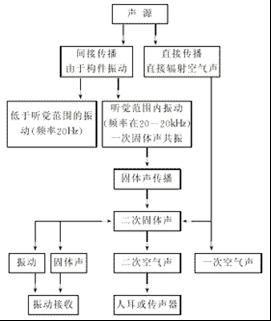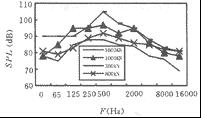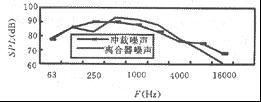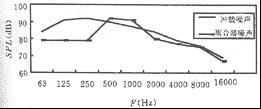First, the analysis of the propagation path of punch noise
Noise propagates in solid, liquid, and gaseous media and is called solid, liquid, and air, respectively, in accordance with its propagating media. Noise is a direct and indirect route of transmission between the source and the recipient. Figure 7 is a block diagram of the punch noise propagation path. The direct transmission of sound refers to the sound of the air produced by the sound source, which is transmitted directly to the recipient without the intermediary of other media. At this time, the acoustic energy changes direction due to reflection; intensity changes due to absorption. For example, the noise of the blow nozzle, the air extrusion noise generated by the falling of the slider is directly transmitted by the sound.

Figure 1 Block diagram of the propagation path of punch noise
The indirect transmission of sound is the sound produced by the sound source, first or in whole or in part in the form of solid sound, liquid sound or air sound in the punch body or in the workshop wall, and then stimulated from a proper radiation condition. Components (such as beds, roofs, etc.) are radiated by air and transmitted to the recipient. In the indirect propagation path, solid sound, liquid sound, air sound, and multiple conversions between individual components can occur.
Second, the spectrum characteristics analysis of punch noise
Noise is composed of many frequencies and intensities, and the components are cluttered. The audio range is very wide, from 1000 to 1000 times from low frequency to high frequency. It is generally not possible or necessary to measure each frequency one by one. For convenience and practical needs, the audio range is usually divided into a number of smaller segments, called bands. The difference between the upper and lower cutoff frequency values ​​of the frequency band is called the bandwidth. The logarithm of the ratio of the bandwidth above and the lower limit frequency, the logarithmic value is usually 2, the unit is octave, ie:
F1/f2=2n or n=log2(f1/f2)
Where f1, f2—the upper and lower cutoff frequencies of the octave relationship
N—multiple between two frequencies
n can be any positive real number, the smaller n is, the finer the division, the shorter the frequency range, and the more time required for measurement. When n=1, that is, when the two frequencies are 1 times apart, it is called octave. When n=1/3, it is called 1/3 octave, and so on.
For the octave, the center frequency range is shown in Table 1.
Table 1 Frequency range of octave (Hz)

The sound waves generated by the sound source as a simple harmonic motion are called simple harmonics. The relationship between the sound pressure at the same time is a sinusoid. This single-frequency sound is called pure tone, and it has a single tone of sound. In addition to the sounds emitted by individual instruments and instruments, pure sound of a single frequency is rare. A general sound is a sound wave synthesized by simple sinusoidal components with different frequencies. This sound is called polyphony. The relationship between the sound pressure and the frequency that constitutes the polyphony is called the spectrum, that is, the variation law of the sound is described in the frequency domain. Different sounds have different spectra, and the sound spectrum is usually represented by a band graph pattern divided by an octave or a 1/3 octave. The noise is synthesized by many uncorrelated spectral beams. In the frequency domain, it can be expressed as several discrete frequency patterns with the same or different sound pressure amplitudes. The main feature is that the phase angle or phase angle difference of each frequency is different. Since the large amplitude of the sound wave synthesis has a large influence on the noise, suppressing the amplitude of this frequency may result in noise reduction. Therefore, when exploring the root cause and mechanism of noise and determining its working scheme, spectrum analysis of noise is an important means.
The spectral analysis of noise is based on the measured sound pressure signal in the frequency domain to analyze its frequency structure. Generally, the frequency is the abscissa, and the main acoustic parameters (such as sound pressure level, sound intensity level, sound power level) are plotted on the ordinate.
The test uses an ND2 precision sound level meter with an octave filter. The principle is to convert the noise signal from the time domain to the frequency domain through an analog filter composed of electronic circuits. The theoretical basis is the Fourier analysis.
It is well known that a periodic function can be decomposed into a series of harmonic components. Conversely, by superimposing a series of harmonic components, a periodic function can be constructed. Therefore, a time-varying function X(T) with a period T can always be expressed as the infinite trigonometric series of the Fourier series as follows
x(t)=a0+a1cos2Ï€f0t+a2cos4Ï€f0t+...+b1sin2Ï€f0t+b2sin4Ï€f0t+...(4)
Where f0 is the fundamental frequency; a0, an, bn are the Fourier coefficients determined by the following equations:

After a simple trigonometric operation, equation (4) can be changed to the following formula:

In the formula:

If f = nf0, the periodic function represented by the Fourier series can be represented in the Cn-f plane, which is the spectrum of the function x(t). It is also possible to represent the phase spectrum (Φn-f) in this plane.
It can be seen that the Fourier analysis can transform the time domain signal into a frequency domain signal. When using the ND2 precision sound level meter to analyze the frequency characteristics of the noise, simply set the “weighted network†switch to the “filter†position. Since the octave filter is inserted between the input amplifier and the output amplifier, the octave is rotated. The filter's selection switch allows for spectral analysis of the noise.
The author conducted a survey on the noise conditions of 275 presses in 18 factories in Beijing, Wuhan, Nanjing, Shanghai, etc., and carried out the punching noise and clutch noise spectrum of 15 different tonnage presses under different processing conditions. Test and plot the results as a graph, as shown in Figures 8-13. Analysis of the above figures can lead to the following rules:

Fig. 8 Noise frequency characteristics of blanking punching of different tonnage punches

Figure 9: Different material blanking noise frequency characteristics

Figure 10 400kN punch punching noise and clutch noise

Figure 11 800kN punch punching noise and clutch noise

Figure 12 1000kN punch punching and clutch noise

Figure 13 350kN vintage punch punching and clutch noise
(1) The peak value of sound pressure level is distributed between 250 and 2 kHz, and the peak value of sound pressure level of small tonnage punch is distributed in the low frequency region (250 to 1 kHz). As the tonnage increases, the peak value of sound pressure level goes to the high frequency range. (500~2kHz) moves. This has a reference for the selection of sound insulation and damping materials. Large tonnage punches generally punch larger workpieces, so the punching force is also large, the elastic deformation energy absorbed by the punching machine is large, and the vibration caused by the sharp release after unloading is also large, so the radiation noise is strong, as shown in Fig. 8.
(2) When punching different materials, the punching noise is quite different. In general, the hard and brittle material is much louder than the soft material (see Figure 9). Moreover, when punching soft materials, the peak value of the octave sound pressure level is distributed in the low frequency range; and when punching the hard material, the peak sound pressure level frequency range is generally wide, and appears at 125 to 8 kHz.
(3) Generally, the sound pressure level of the punching noise is greater than the clutch noise. However, for the old-fashioned small-tonnage punch, the clutch noise is larger than the punching noise. The reason is that the old-fashioned punch press generally uses a rigid clutch.
Granite Wire Saw,Wire Saw for Quarrying Granite,Diamond Wire Saw for Granite
Bontai Diamond Tools Co., Ltd. , http://www.fjdiamondblades.com